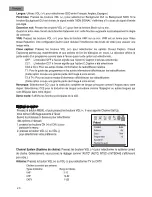
GRUNDIG Service
2 - 8
CUC 7301
Schaltungsbeschreibung / Circuit Description
3.10 Zeilenoszillator
Bei diesem IC-Konzept generiert der Zeilenoszillator die Zeilenfrequenz
vollständig intern. Er besitzt keine externen Bauteile. Somit sind weder
die freilaufende Horizontal- noch die freilaufende Vertikalfrequenz
einzustellen.
3.11
ϕ
1-Regelung
Die
ϕ
1-Regelung stellt eine Frequenzregelung dar. Damit wird der
Horizontal-Oszillator auf die Frequenz des Zeilensynchronsignals
geregelt. Hierzu wird die Frequenz des Zeilensynchronsignals mit der
Frequenz des Horizontal-Oszillators verglichen.
Ein
ϕ
1-Regelkreis definiert die Zeitkonstante der Regelspannung die
an PIC150-(40) ausgeben wird. Die Regelspannung verschiebt den
Zeilenoszillator solange, bis die Frequenzen übereinstimmen.
3.12
ϕ
2-Regelung
Die
ϕ
2-Regelung ist die Phasenregelung. Sie stellt den Phasenbezug
zwischen dem Zeilensynchronsignal und der tatsächlichen Position
des Elektronenstrahls her. Schaltungs- und strahlstrombedingt beste-
hen unterschiedliche Verzögerungszeiten zwischen dem Außen-,
dem Triggersignal und der tatsächlichen Reaktion der Zeilenendstufe.
Diese Unterschiede werden durch die
ϕ
2-Regelung ausgeglichen.
Für die Strahlposition ist der Zeilenrückschlagimpuls vom Zeilentrafo
am IC150-(38) angeschlossen. Die
ϕ
2-Regelung erzeugt aus dem
Oszillatorsignal und dem Zeilenrückschlagimpuls eine Regelspannung
am IC150-(39), die mit C166 gesiebt wird.
3.13 Supersandcastle SSC
Das 3-pegelige Supersandcastlesignal IC150-(38) ist ein Kombi-
Impuls bestehend aus dem Horizontal- Vertikal- und Burstauftastimpuls.
Der Zeilenrückschlagimpuls (H-Sync) wird über T523, CR163 dem
IC150 zugeführt. Der Bildrückschlag- und Burstkeyimpuls werden im
IC generiert.
Bei Ausfall der Vertikalablenkung zieht IC400-(7) den SSC-Pegel über
R401 auf "Low" und steuert an IC150-(18, 19,
20) RGB den Bildschirm dunkel. Dabei werden die Analogwerte auf
"Low" gezogen.
3.14 Cut-Off-Einstellung
Die statischen Arbeitspunkte der Bildröhre werden über die Cut-Off-
Automatik stabil gehalten. Dazu gibt der IC150 in der Zeile 23, 24 und
25 einen Impuls an die R, G, B-Kathoden aus, um den Strahlstrom
jedes Systems zu messen (ca. 10
µ
A). Der Cut-Off-Strom während der
Meßzeilen wird über Widerstand CR156 dem IC150-(14) zugeführt.
Der IC vergleicht diesen Strom mit einem internen Referenzwert und
bildet daraus den Arbeitspunkt für den Schwarzwert der Videoendstufen
bzw. Cut-Off Spannung der Bildröhre.
3.15 HDR-Endstufe
Nach interner Verstärkung steht an Pin 37 das Horizontale Ansteuer-
signal für den Zeilenendstufentransistor.
RGB Ausgangsverstärker
RGB Output Amplifier
RGB intern
Internal RGB
RGB von Scart
oder Videotext
RGB from Scart
or Videotext
Data
Kontrast
Contrast
Helligkeit
Brightness
RGB extern
External RGB
RGB zur
Bildrohrplatte
RGB to the
CRT panel
Spitzenweiß
Begrenzung
Peak White
Limiting
22
23
24
21
25
17
10
19
18
3.10 Line Oscillator
With this IC concept, the line frequency is generated completely inside
the line oscillator. The IC is not connected to external components so
that it is not necessary to adjust the free running horizontal and the free
running vertical frequency.
3.11
ϕ
1 Phase Control
The
ϕ
1 phase control stage is for controlling the frequency. This stage
adjusts the frequency of the line oscillator to that of the line synchron-
ising pulse. For this, the frequency of the line synchronising pulse is
compared with the line oscillator frequency.
A
ϕ
1 phase control stage defines the time constant of the control
voltage which is fed out at IC150-(40). The control voltage shifts the line
oscillator until the frequencies are equal.
3.12
ϕ
2 Phase Control
The
ϕ
2 phase control stage is for controlling the phase position of the
line drive pulse. This determines the phase off-set between the line
synchronising pulses and the actual position of the electron beam.
Dependent on the circuit components and the beam current, the delay
time between the external signal, the trigger signal and the actual
reaction of the line output stage is different. These differences are
compensated for by the
ϕ
2 control.
To identify the position of the electron beam the line flyback pulse from
the line output transformer is applied to IC150-(38). From the oscillator
signal and the line flyback pulse the
ϕ
2 controlling stage produces a
control voltage at IC150-(39) which is filtered by C166.
3.13 The Super Sand Castle - SSC
The 3-level SSC signal IC150-(38) is a composite pulse consisting of
the line flyback, the field flyback, and the burst key pulses. The line
flyback pulse (H-Sync) is fed through T523, CR163 to IC150. The field
flyback and burst key pulses are generated inside the IC.
If the field deflection stage fails, IC400-(7) pulls the SSC level to "Low"
via R401 and thus blanks the CRT at IC150-(18, 19, 20) RGB. In doing
so, the analog values are set to "Low".
3.14 Setting of the Cut Off Voltage
An automatic cut-off controlling stage ensures that the static working
points of the CRT are held stable. For this, IC150 feeds out a pulse to
the R, G, B cathodes during the lines 23, 24 and 25 to measure the
beam current of each system (approx. 10
µ
A). The cut-off current
during the measuring lines is fed via the resistor CR156 to IC150-(14).
The IC compares this voltage with an internal reference value to
determine the working point for the black level of the video output
stages and the cut-off voltage of the CRT respectively.
3.15 The HDR Output Stage
Following an amplification stage the horizontal drive signal for the line
output transistor is provided at Pin 37.
















































